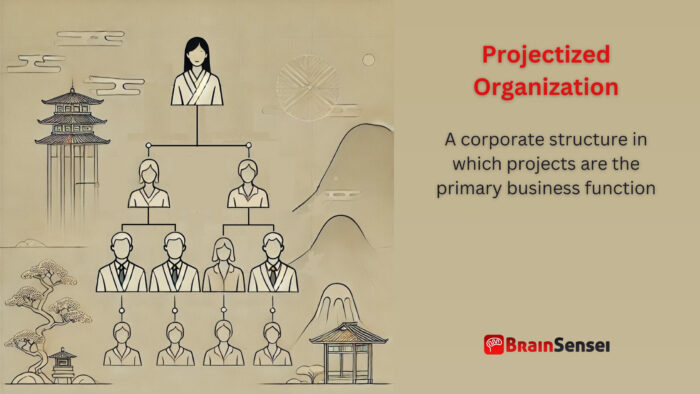
Projectized Organization
What is a Projectized Organization?
A projectized organization is a corporate structure in which projects are the primary business function. Resources are allocated based on project needs rather than departmental hierarchies. In this structure, project managers have full authority over resources, budgets, and decision-making, ensuring streamlined execution and clear accountability.
Key Takeaways
- Project-focused: All company operations revolve around projects rather than functional departments.
- Strong Project Manager Authority: Project managers have the highest decision-making power.
- Resource Allocation Efficiency: Teams are assigned based on project requirements rather than fixed departmental roles.
- Clear Accountability: Defined roles and responsibilities ensure clear ownership of deliverables.
- Potential Downsides: This can lead to job insecurity post-project completion and increased competition for resources.
Understanding a Projectized Organization
How It Works
In a projectized organization, projects are the core operational units, meaning employees report directly to project managers rather than functional heads. This structure enhances agility, accelerates decision-making, and fosters innovation by dedicating resources exclusively to active projects. Organizations that deal primarily with client-driven work—such as construction firms, IT consultancies, and event management companies—often adopt this structure for efficiency.
Notes
- Project teams are temporary, dissolving once the project ends.
- Resource availability may fluctuate, impacting project stability.
- Employee roles can be dynamic, requiring adaptability to shifting assignments.
- Cross-functional collaboration is enhanced as teams operate without departmental silos.
- Project success determines business success, making project management expertise critical.
Related Terms
- Matrix Organization: A hybrid structure where employees report to project and functional managers.
- Functional Organization: A traditional hierarchy where employees work within departments with clear vertical reporting lines.
- Project Portfolio Management (PPM): The centralized management of multiple projects to align with business objectives.
- Program Management: Overseeing related projects to achieve strategic benefits beyond individual project outcomes.
- Project Governance: A framework that ensures projects align with corporate strategy and deliver intended value.
Examples of Projectized Organization in Different Industries
Construction Industry
A large construction firm operates with a projectized structure, where each construction project—such as a skyscraper or bridge—is managed independently. Project managers control budgets, hiring, and execution timelines, ensuring the success of each initiative. Once a project is complete, managers transition employees to new assignments or different projects.
For instance, a significant infrastructure company working on a high-speed rail network assigns a dedicated project manager to oversee all aspects, including procurement, compliance, and workforce management. Engineers, architects, and site workers report directly to the project manager, ensuring efficiency and minimizing bureaucratic delays. This approach enables the company to complete projects on time and within budget.
Another example is the housing sector, where a real estate development firm constructs residential complexes. Each complex is independent, with a designated project team managing all activities from site selection to final inspections. This structure ensures clear accountability and faster problem resolution.
IT & Software Development
A software consultancy follows a projectized model, assigning engineers, designers, and testers to client-specific projects. The project manager oversees the entire development lifecycle, from requirement gathering to deployment, without interference from functional departments. Team members shift to new software projects as clients and deliverables evolve.
For example, a multinational IT firm working on a cloud-based fintech application assigns a project manager who leads software developers, cybersecurity experts, and quality assurance specialists. Each member works exclusively on the project, which ensures optimal resource utilization. Upon completion, the team moves to another fintech project or is reassigned based on business needs.
In game development, a projectized structure is commonly used. A gaming studio working on an open-world RPG forms dedicated teams, including artists, programmers, and narrative designers, who all report to the project manager. This focused approach ensures seamless collaboration and timely milestone completion.
Aerospace & Defense
An aerospace company working on government defence contracts structures its teams around individual projects, such as satellite launches or fighter jet development. Dedicated project managers coordinate resources, testing phases, and regulatory compliance while ensuring alignment with strict government deadlines.
For instance, a space exploration company designing a Mars rover follows a projectized approach. Mechanical engineers, propulsion specialists, and software developers work under the guidance of a project manager. Each phase, from prototyping to launch, is managed as a separate sub-project, ensuring clear timelines and accountability.
Similarly, a defence contractor manufacturing advanced drones follows a strict projectized structure. A project team, including aeronautics engineers, defence analysts, and quality inspectors, focuses entirely on the drone program. Since these projects often span several years, a projectized model ensures sustained progress and focused expertise.
This model applies to aircraft manufacturing, where companies like Boeing or Airbus assign dedicated project teams to develop new models. A project manager ensures that production, testing, and regulatory compliance are seamlessly executed, improving efficiency and maintaining high safety standards.
By implementing a projectized structure in these industries, companies can optimize efficiency, maintain project focus, and deliver high-quality results within set deadlines.
Use Cases of a Projectized Organization
South America (Infrastructure)
Brazil’s government initiates a massive highway construction project, employing a projectized organizational structure to streamline execution. Project managers oversee engineers, procurement specialists, and labour teams, ensuring efficient coordination without bureaucratic delays. The project’s structured approach ensures teams complete critical milestones such as environmental assessments, contractor bidding, and material procurement. The clear hierarchy of authority in this projectized framework helps in quick decision-making, ensuring smooth execution and adherence to government regulations.
Europe (Event Management)
A European event planning company uses a projectized model, forming teams for each significant event, such as music festivals or corporate conferences. Resources, marketing, and logistics are aligned per event, allowing rapid adaptation to different client requirements. Each project manager has full authority over event planning, ticket sales, sponsorships, and logistics, reducing unnecessary delays. This structure allows the company to plan and execute multiple high-profile events concurrently while maintaining high-quality experiences for attendees and stakeholders.
Asia (Renewable Energy)
A solar power company in India adopts a projectized structure to manage large-scale solar farm installations. Each project team includes engineers, environmental analysts, and finance experts, focusing entirely on the solar plant’s development from land acquisition to operational launch. Given that renewable energy projects often require compliance with strict government regulations, the projectized model ensures dedicated attention to each phase, from securing funding to implementing cutting-edge energy storage solutions. The project manager’s streamlined focus ensures efficient handling of technological advancements, sustainability metrics, and cost management, leading to successful and timely project completion.
Best Practices for Implementing a Projectized Organization
Implementing a projectized organization requires careful planning and adherence to best practices to ensure efficiency, sustainability, and employee satisfaction. Below are key best practices to help organizations transition smoothly and optimize the benefits of a projectized structure.
Develop a Strong Project Management Culture
To ensure success, organizations must instill a strong project management culture. This approach involves training employees in project management methodologies such as Agile, Scrum, or PMI standards. Encouraging certifications like PMP (Project Management Professional) and PRINCE2 can enhance project managers’ effectiveness. Organizations should also promote knowledge sharing and lessons learned from past projects to refine processes continually.
Plan for Resource Allocation Stability
A common challenge in projectized organizations is fluctuating resource availability. Workforce planning tools and resource management software such as Microsoft Project, Asana, or Jira can help optimize resource distribution. Ensuring employees transition smoothly between projects without prolonged idle time or burnout is crucial for sustainability.
Provide Career Development Opportunities
Since projectized structures focus on temporary assignments, employees may experience uncertainty regarding long-term career growth. Companies must offer mentorship programs, upskilling opportunities, and clear career progression paths to retain top talent. Assigning employees to short-term and long-term projects can also create stability.
Strengthen Communication and Collaboration
Projectized organizations rely on efficient teamwork and clear communication. Collaboration tools like Slack, Microsoft Teams, or Trello can enhance coordination. Additionally, regular stand-up meetings, project retrospectives, and cross-functional workshops can foster engagement and prevent misalignment between project goals and corporate strategy.
Align Projects with Corporate Strategy
A well-structured projectized organization ensures that projects contribute to overarching business goals. Establishing a project governance framework helps align strategic objectives and project execution. Portfolio management strategies ensure that resources are allocated to high-impact projects, maximizing return on investment.
Implement Risk Management Practices
Every project carries inherent risks, from scope creep to budget overruns. Proactively identifying risks and establishing mitigation plans ensures that projects stay on track. Risk assessment frameworks such as SWOT analysis, Monte Carlo simulations, and failure mode effect analysis (FMEA) can help organizations anticipate challenges and develop response strategies.
Foster a Flexible and Adaptive Workforce
Given the dynamic nature of projectized organizations, employees should be encouraged to develop diverse skill sets. Cross-training and rotational assignments can improve workforce adaptability, allowing employees to transition between different types of projects seamlessly. Encouraging a growth mindset ensures employees remain engaged and motivated.
Utilize Performance Metrics and KPIs
Measuring project performance is crucial for continuous improvement. Organizations should establish key performance indicators (KPIs) such as on-time delivery, budget adherence, stakeholder satisfaction, and team efficiency. Data-driven decision-making enables organizations to identify bottlenecks and optimize processes.
Ensure Stakeholder Engagement
Project success depends not only on internal teams but also on effective stakeholder engagement. Regular progress updates, stakeholder feedback loops, and transparent reporting mechanisms enhance trust and collaboration between project teams and external clients or executives.
Balance Autonomy with Organizational Oversight
Organizations must balance project managers’ significant authority and accountability to avoid micromanagement. Establishing a structured review process, including milestone check-ins and executive oversight, prevents deviations from project objectives while maintaining operational efficiency.
Adhering to these best practices can help organizations mitigate risks, optimize performance, and create a sustainable projectized structure that maximizes employee satisfaction and business success. Transitioning to a projectized model requires a strong strategic foundation, and these guidelines help ensure a smooth and effective implementation.
Projectized Organization: Common Mistakes and Issues
Implementing a projectized organization can bring numerous benefits, but it also comes with potential pitfalls that, if not appropriately addressed, can lead to inefficiencies, resource mismanagement, and employee dissatisfaction. Below are some of the most common mistakes and issues organizations face when adopting this structure.
Lack of Clear Communication Channels
One of the most significant challenges in a projectized organization is communication breakdown. Cross-project collaboration can suffer because organizations structure teams rather than functional departments around projects. Without well-defined communication channels, team members might miss essential updates, leading to misalignment between project objectives and actual execution. Implementing collaborative tools like Slack, Microsoft Teams, or Asana can help mitigate this issue by ensuring transparency and real-time information sharing.
Inadequate Resource Planning in Projectized Organization
Projectized organizations often experience resource allocation issues, particularly when transitioning between projects. If there’s no strategic resource management in place, employees may be overworked due to overlapping project demands or underutilized when a project concludes. Workforce planning tools and predictive analytics can help organizations allocate personnel more effectively, ensuring an optimal balance between project needs and workforce capacity.
Employee Job Insecurity and High Turnover
Since teams are disbanded upon project completion, employees may feel a lack of job security, leading to increased turnover rates. Without a clear career path or long-term stability, talented professionals may leave for opportunities in more traditional structures. Organizations can counteract this by offering continuous learning opportunities, career development programs, and a structured project reassignment strategy that ensures employees transition smoothly from one project to another.
Overemphasis on Project Goals at the Expense of Company Strategy
While a projectized structure prioritizes individual project success, it sometimes does so at the cost of long-term company objectives. Teams may become overly focused on delivering a specific project within budget and time constraints without considering its broader impact on the company’s strategic vision. Regular executive oversight and project portfolio alignment reviews can ensure that each project supports the company’s overall mission and goals.
Resistance to Change and Cultural Shifts
Transitioning from a functional or matrix structure to a fully projectized model requires a significant cultural shift. Employees accustomed to working within a department may resist moving to a more fluid and project-driven work environment. Employees may struggle to adapt to the new structure without proper change management strategies, reducing overall productivity. Leadership must prioritize change management initiatives, including training programs, workshops, and clear communication on the benefits of the transition.
Knowledge Retention Issues
When a project concludes, team members often move to other assignments, which can result in a loss of valuable institutional knowledge. Without proper documentation and knowledge-sharing protocols, future projects may repeat past mistakes or miss opportunities to build on previous successes. Organizations should establish comprehensive documentation practices and invest in knowledge management systems to ensure continuity and efficiency.
Insufficient Stakeholder Engagement
Project managers sometimes focus so intently on meeting internal deadlines and deliverables that they neglect external stakeholder engagement. Whether it’s clients, customers, or business executives, failing to involve key stakeholders early and consistently can result in misaligned expectations and project failures. Setting up regular stakeholder check-ins, status reports, and feedback loops can help maintain engagement and ensure project success.
Micromanagement by Project Managers
While projectized organizations grant project managers significant authority, some may misuse this power by micromanaging every aspect of the project. Such micromanagement leads to inefficiencies, lower employee morale, and slower decision-making processes. Encouraging a balance between autonomy and structured oversight ensures that employees feel trusted while still maintaining accountability.
Budgeting and Cost Control Challenges in Projectized Organization
Since projectized organizations rely on temporary teams, budget planning can be inconsistent across projects. Some projects may receive excessive funding without a standardized budgeting framework while others face resource shortages. Implementing standardized financial planning processes, clear budget allocation policies and regular financial audits can prevent cost overruns and ensure equitable resource distribution.
Difficulty in Scaling the Projectized Organization Structure
While projectized organizations work well for specific industries like construction, IT consulting, and event management, they may not be as effective in large-scale enterprises with diverse functions. Scaling a projectized structure requires careful evaluation of the organization’s needs and a potential hybrid model that blends projectized and functional elements. A phased implementation approach, rather than a complete overhaul, can help companies transition effectively without disrupting operations.
By proactively addressing these common mistakes and issues, organizations can optimize their projectized structure, ensuring a smoother workflow, higher employee satisfaction, and improved project success rates. Continuous evaluation and adaptation of processes are essential to maintaining efficiency and avoiding these pitfalls in the long run.
Projectized Organization: Frequently Asked Questions (FAQs)
What are the advantages of a projectized organization?
A projectized structure enhances efficiency, accountability, and adaptability, making it ideal for companies focused on project execution. Project managers have complete control over resources, ensuring streamlined decision-making and rapid response to project needs.
What industries commonly use a projectized organization structure?
Industries such as construction, IT consulting, aerospace, defence, event management, and renewable energy frequently adopt projectized organizations due to their project-driven nature.
How does a projectized organization differ from a matrix organization?
A projectized organization gives project managers full authority, while a matrix structure balances power between functional and project managers, leading to shared decision-making.
What challenges arise in a projectized organization structure?
Employee uncertainty, fluctuating resource availability, and potential silos between projects can be challenges. Organizations must invest in workforce planning and career development to mitigate these risks.
Can a company combine projectized and functional structures?
Yes, many companies adopt a hybrid or matrix model to balance project agility with functional expertise, maintaining stable departmental structures while emphasizing project execution.
Additional Resources
Preparing for a PMI certification?
- Exam Prep Courses: PMP®, CAPM®, and PMI-ACP®
- Exam Simulators: PMP®, CAPM®, PMI-ACP®, PMI-PBA®, PMI-RMP®, PMI-SP®, PgMP®, and PfMP®
- Professional Development Units (PDUs): 15, 30, and 60 PDU Bundles



